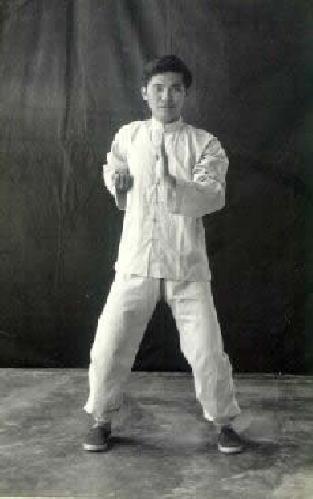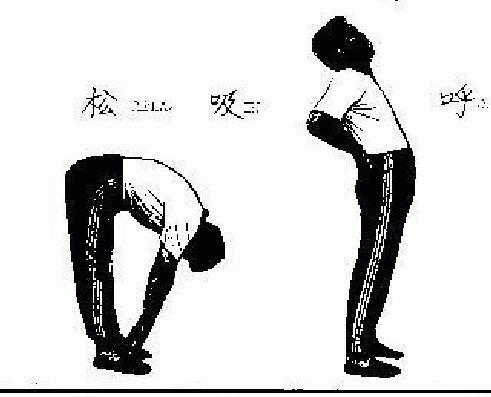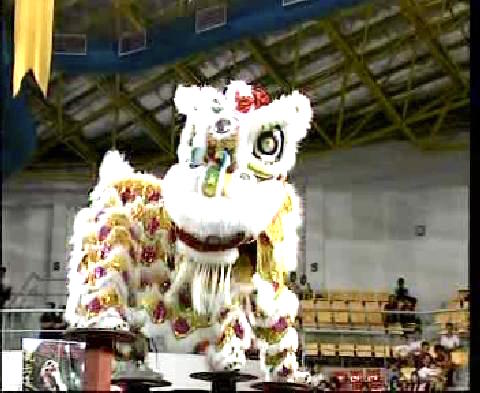May 2009 (Part 2)
SELECTION OF QUESTIONS AND ANSWERS

Grandmaster Wong lets out a top secret. The Siu Lin Tau Set, shown above in his young days, was the main method he developed internal force in the Wing Choon Kungfu he learned from Grandmaster Choe Hoong Choy
Question 1
I have a potential student who is a kidney failure patient, who has asked to join my qigong class even though the class has already started.
I have always felt very sorry for kidney dialysis patients, and want to do my best to help this student. However, most of the students in my current course came with fairly minor ailments, so I am not sure how a more serious case can fit in with my other students. Interestingly, of all the students in my class, the one with the most serious condition of diabetes is progressing the best and fastest.
I would very much like to help this kidney patient, but I also want the best for him, so I have asked him to join Sifu's intensive qigong course later this year. However, he does want to join my course.
Should I accept him as my student, and then ask him to later join Sifu's intensive course?
May I humbly seek Sifu's advice on this?
— Sifu Zhang Wuji, Singapore
Answer
The wonderful thing about qigong, especially high-level qigong taught by a competent teacher, is that it serves the different needs of vastly different types of people, ranging from the seriously sick to the vigorous martial artists, ranging from the stressful businessmen in crowded cities to the peaceful spiritual cultivators on mountain tops.
Wanting the best for our students is a hallmark of a good teacher, and is a value we cherish and practice in our school. This includes not just teaching our students our best but also directing him to other teachers or healers if they can serve him better. This does not happen very often in our school, certainly not because we do not practice what we say but because we honestly believe we can give him the best means to fulfill his needs.
If a student is sick with some illness that we know conventional medicine will cure him speedily, we would surely ask him to see a doctor. If a group of potential students tell us that they want to learn from us so as to win prize money in competitions, which happily very seldom happen in our school, we would ask them to go to other schools.
Question 2
This is a follow-up of my earlier letter. Yesterday night, the kidney patient called me to ask if he could join the course. He said that he could not wait for Sifu's course and he wanted to join the course even though it had begun.
I was not sure if I should take him as a student. Knowing our philosophy and the fundamental cause of his kidney failure, I believe I can help him. But I felt that the best thing he could do was to attend Sifu's intensive course, and I can thereafter follow up with him.
But when he called last night, I found myself agreeing to let him join the course, and I also agreed to give him make-up lessons to help him catch up with the rest of the class. I am sorry I did not wait for Sifu's instructions before making a decision as things progressed very quickly.
Answer
Yes, you have done the right thing throughout. This is due to your good cultural background, sound understanding of qigong philosophy and practice, and correctly listening to your intuition (which in some culture is also referred to as listening to God).
Taking your regular qigong class is the best choice. In fact he may not need to take my Intensive Qigong Course if practicing what he has learnt from you is producing good result, which I believe it will. If he still wishes to attend the Intensive Course, he is welcome.
It is correct and kind of you to give this student some theoretical background and practical lessons which he has missed.
In Chinese medical philosophy, all healing starts from the “heart” (which means “mind” in English). From my many years of helping people overcome serious diseases, I have discovered that the most important thing is to instill in patients the will to live.
The second most important thing is to convince them that their diseases, especially so-called incurable diseases, can be overcome. I always speak with conviction, and my patients can readily feel it.
Teaching them the remedial exercises or prescribing them the treatment is the third important. It will be assuring to tell him the fact, which he may not yet know, that many people have recovered from kidney problems by practicing qigong learnt from us.

An old picture showing Grandmaster Wong performing "Nourishing Kidneys"
Question 3
I meditated about what to teach this student and the message I got was that I should not focus only on his kidney problem. Rather, I should be teaching him what I teach the class, to use any pattern to generate a qi flow. This is partly because I suspect his real problem is not at his kidneys anyway. May I have Sifu's advice whether my view is correct?
Answer
Teaching him generating energy flow is the best choice in the teaching approach. As you have correctly stated, his root problem may not be at the kidneys, though the symptoms are located there. Progressing to self-manifested chi movement is excellent, as this is the “platinum chi kung exercise” to overcome any illness.
It certainly sounds ridiculous to those used to the Western medical paradigm, but from the chi kung and traditional Chinese medical perspective, it does not matter where the energy blockage is, as long as the energy flow is powerful and consistent enough, it will eventually reach and break through the blockage. The key words are “powerful” and “consistent”. If the energy flow is not powerful enough, or if the student (or patient) does not practice consistently, the break-through may not occur.
Nevertheless, it is also advisable to teach him exercises that are specially related to the kidneys. “Pushing Mountain” and “Nourishing Kidneys” are two excellent choices. Besides enabling him to have a general energy flow which will overcome the cause of his problem, these two exercises also focus on his symptoms.
In traditional Chinese medical terms, the cause is referred to as the “root”, and the symptoms as “branches”. Basically we should treat the “root” and not the “branches”. But when the “branches” or symptoms are serious, it will be necessary to treat them first, of course without neglecting the root.
Question 4
With Sifu's permission, I would also like to teach him (and the rest of the class) an introduction to self-manifested qi flow. Quite a number of students have already achieved qi flow during the first lesson, so I think they are well primed for less vigorous qi movement.
Answer
Generally it is best for both the teacher and the students to let self-manifested chi movement develop naturally. In this way both the teacher and the students will respectively develop the skills in teaching and in practicing it. Self-manifested chi movement is actually a very safe exercise if taught by a competent teacher and practiced by competent students. But it can be risky if the teacher or the students are incompetent.
However, there may be occasions when this general policy is modified. In classical Chinese military terms, a general at the front-line of war might modify an emperor's order if the situation warranted it. Yours looks like such a situation. Self-manifested chi movement is excellent for this student and others who may have serious illness to overcome. Those who are quite healthy, can progress at a gradual pace.

This chin-na counter by Grandmaster Wong against Sifu Goh Kok Hin's whirlwind kick is reminiscent of the Drunken Eight Immortals kungfu he learned from Grandmaster Ho Fatt Nam
Question 5
I'm very interested in learning traditional Shaolin Kung Fu. I search for any information about it on the internet and in books. I love to read your books. They are very informative.
Now I have found a Hung Gar Kuen school in my town. On this website there is the name of a master and his teacher and grand-teacher. I can't find any information about these three masters who live in Malaysia except from this German website. Do you probably know more about these masters? Is this the same style you are teaching too?
— Daniel, Germany
Answer
I am sorry I do not know the three Hoong Ka (Hung Gar) masters you mentioned and who live in Malaysia. Nevertheless, you may be interested in the following historical background. Yes, I teach Hoong Ka Kungfu too, but like the early masters I call it “Shaolin”.
Hoong Ka Kungfu, more commonly known as Shaolin at that time, was very popular in Malaysia where many kungfu masters from China migrated to, and where the fists rather than laws were the order of the day.
At that time in the early 1900s the two most famous Hoong Ka masters were Ng Yew Loong and Lou Chan Wei, who happened to be my sigungs, or teacher's teachers. This was no co-incident because my sifu, or teacher, Lai Chin Wah, who was more popularly known in kungfu circles as Uncle Righteousness, chose to learn from the best kungfu teachers of his time.
My sifu succeeded them as the best known kungfu master of his time, which was about 1950s and 60s. Two other well-known kungfu masters at that time were Ng Siew Hoong and Leong Khuen. Ng Siew Hoong also practiced Hoong Ka Kungfu, whereas Leong Khuen, who was better known by his nickname “Sor Khuen”, which means “Crazy Khuen” because he fought like crazy in many fights, practiced Chow Ka Kungfu.
Chow Ka Kungfu is also called “Hoong Tau Choy Mei”, which means “Hoong at the Begining, Choy at the End”, because Chow Ka practitioners start with Hoong Ka Kungfu and conclude with Choy Ka Kungfu.
It is interesting to note that the kungfu sets taught by these Hoong Ka masters were different from those taught by many Hoong Ka masters today who are mostly from the Lam Sai Weng's lineage. Uncle Righteousness' famous sets were “Dragon's Strength” and “Flower Set”, while Ng Siew Hoong's famous sets were “Four Gates” (which was, however, different from the “Four Gates” in our school, Shaolin Wahnam), and “Tiger Claws”. The kungfu sets of many Hoong Ka masters today are “Taming the Tiger”, “Tiger-Crane” and “Iron Wire”. The forms as well as the philosophy and combat application are the same.
“Tiger-Crane” was also taught by Uncle Righteousness, but it was different from that from Lam Sai Weng's lineage. Uncle Righteousness' set has only 36 patterns, whereas that of Lam Sai Weng has 108.
It is also worthy of note that these great masters, including Lam Sai Weng, called their kungfu “Shaolin”. It was later that their descendents call it “Hoong Ka” (“Hung Gar”).
In the 1970s and 1980s the two well known Hoong Ka kungfu schools were Chin Wah Hoong Ka Gynmasium and Hung Kuen Koon, which means “School of Hoong Ka Kungfu”. Chin Wah Hoong Ka Gymnasium was headed by Wong Choy Wah, who was my siheng (senior kungfu brother), and Hung Kuen Koon was headed by Poon Cham Chuin, who was my sisook (junior kungfu uncle) as he learned from my sigong (kungfu grandfather), Lou Chan Wei, when my sisook was a child. Later Poon Cham Chuin went to Hong Kong to learn from a Hoong Ka master from the Lam Sai Weng's lineage. Hence, his kungfu sets also included “Taming the Tiger” and “Iron Wire”.
These two Hoong Ka kungfu schools were in Penang, which had more than a hundred kungfu schools, big and small, at that time. This showed how widely practiced kungfu was in Penang. In Kuala Lumpur, the capital of Malaysia, probably the best known kungfu school was Lien Seng Koon, which means “School of Combined Victory”. Amongst a few styles of kungfu taught there was Hoong Ka, taught by Cheong Weng Khuen, who is a third-generation successor from Wong Fei Hoong, who was Lam Sai Weng's teacher. In other words, Lam Sai Weng was Cheong Weng Khuen's sibak, or senior kungfu uncle.
Another great master who taught at Lien Seng Koon was Chen Choy, who was a Choy-Li-Fatt patriarch. He was also instrumental in creating what is now known in Lion Dance as “nam see pak mou”, which means “Southern Lion danced in a Northen Lion style”. Prior to this, Southern Lion Dance, like Southern Shaolin Kungfu, was ground-based well known for its stances, whereas Northern Lion Dance was acrobatic.
Chen Choy changed this, he made Southern Lion acrobatic, jumping agily from poles to poles. Today, Malaysia has the highest level of Lion Dance in the world, winning, as far as I know, all international Lion Dance competitions, relocating favorite teams like China and Hong Kong to second and third places. Malaysian Lion Dance has much to thank Sifu Chen Choy.
Question 6
I remember reading that you learned a drunken set, Jui Baat Seen Kuen, from one of your teachers. Do you teach this to any of your senior students, or to anyone?
— Randy, USA
Answer
I learned two versions of “Jui Baat Seen” or “Drunken Eight Immortals” separately from two of my sifus, Sifu Ho Fatt Nam and Sifu Choe Hoong Choy.
Sifu Ho Fatt Nam did not teach me a set; he taught me the essence. For example, he taught me the signature technique and its typical application of each of the Eight Immortals. The signature patterns are as follows:
- Old Immortal Zhang Rides Donkey Reversely
- Immortal Han Waves Fan
- Immortal Li Holds Clutch
- Immortal Lu Draws Sword
- Immortal Choe Plays Clappers
- Immortal Hon Plays Flute
- Lady Immortal Ho Casts Flowers
- Child Immortal Lan Carries Basket
There is no immediate plan to teach the “Drunken Eight Immortals” in our school, though many combat principles of the “Drunken Eight Immortals” are found in what we practice.
Some of the important principles found in “Drunken Eight Immortals” that I use in our combat application in Shaolin Wahnam today are “defence-cum-counter”, “no defence direct counter" and “flowing with the opponent's momentum”.
For example, when an opponent executes a kick, we may use the Drunken Immortal pattern “Immortal Han Waves Fan” to lock his leg, which utilizes the principle “flowing with the opponent's momentum”. A similar pattern in Shaolin Kungfu is “White Monkey Catches Pig”.

“Nam See Pak Mou”, which means “Southern Lion danced in a Northen Lion style”, which is very popular today, was first invented by Sifu Chen Choy of Malaysia
Question 7
Did you learn any specified force training for the Drunken Set?
Answer
I did not learn any force training specially connected with the Drunken Style.
Both versions of Drunken kungfu were taught to me as part of my Shaolin and Wing Choon training respectively. In other words, the force I used in Drunken kungfu was derived from the force training from my Shaolin and Wing Choon systems.
There were many methods of internal force training in Shaolin, but the one I liked and practiced most was “One-Finger Shooting Zen”. In Wing Choon Kungfu, surprising it may be to many people as it is normally kept as a top secret, the main internal force training method was Siu Lin Tau, the fundamental Wing Choon set.
Question 8
I've heard many legends about a man named Su Haat Yi or “Drunken Su the Beggar” who supposedly taught a form of Drunken kung fu to Wong Fei Hoong who later used it as a secret weapon. Do you know if there is any truth to these legends?
Answer
Yes, Su Haat Yi or Beggar Su taught the Drunken Fist to Wong Fei Hoong. It is worthy of note that Su Haat Yi's style was Hoong Ka (called Shaolin at his time) and not Drunken Style as it is sometimes believed.
While Wong Fei Hoong was expert at Drunken kungfu and incorporated it into his own Shaolin Kungfu (please note that Wong Fee Hoong called his kungfu “Shaolin” too, though today many practitioners from his lineage call it “Hoong Ka”), his secret weapons were not Drunken kungfu techniques but Tiger-Claws and No-Shadow Kicks.
Interestingly, the Drunken kungfu I learned from my Shaolin master, Sifu Ho Fatt Nam, was not from Shaolin but from Taoist Kungfu. Sifu Ho Fatt Nam was also a great Taoist master.
And my Drunken kungfu I learned from my Wing Choon master, Sifu Choe Hoong Choy, was not from Wing Choon Kungfu but from Choy-Li-Fatt. The patriarch who brought Wing Choon Kungfu to the Choe Family was originally a Choy-Li-Fatt master.
These incidents showed that past masters were not closed in their learning and teaching, a lesson that can benefit many modern masters.
LINKS
Selected Reading
- Scattered Sakura Petals
- The Miraculous Made Manifest in Minutes
- The Standard of Lion Dance we Aim to Attain
- Brick-Breaking Fun
- Really Experiencing Combat Application, Internal Force and Spiritual Cultivation at Intensive Course
